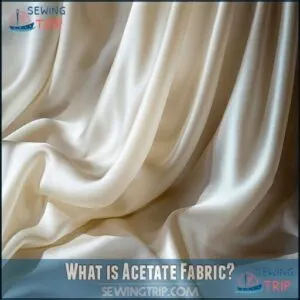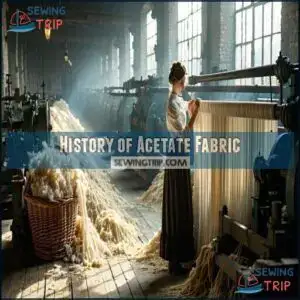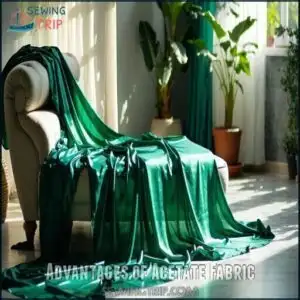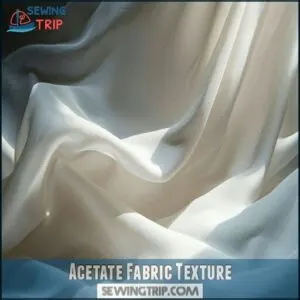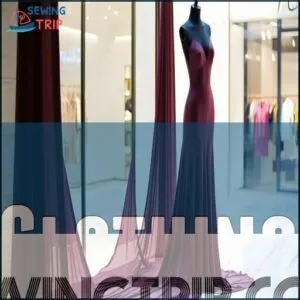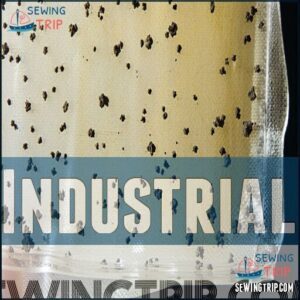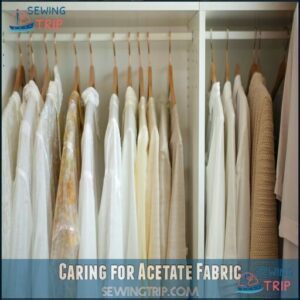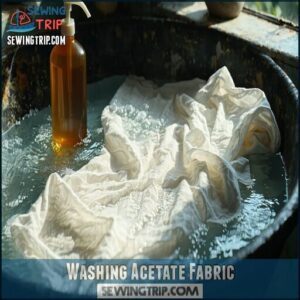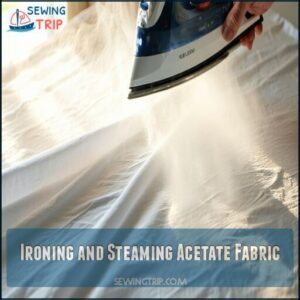This site is supported by our readers. We may earn a commission, at no cost to you, if you purchase through links.
 You’ll recognize acetate fabric by its silk-like drape and subtle sheen.
You’ll recognize acetate fabric by its silk-like drape and subtle sheen.
This semi-synthetic material offers impressive wrinkle resistance while maintaining breathability.
Acetate fabric characteristics include quick-drying properties, softness against skin, and excellent color retention that won’t fade after washing.
It’s lightweight yet durable enough for everyday wear, though you’ll want to avoid high heat which can melt or deform it.
Like a chameleon of textiles, acetate adapts well to dyes, producing vibrant, rich colors that stand out in any wardrobe.
Wait until you discover the surprising historical connection between acetate and early film production!
Table Of Contents
- Key Takeaways
- What is Acetate Fabric?
- History of Acetate Fabric
- Advantages of Acetate Fabric
- Disadvantages of Acetate Fabric
- Acetate Fabric Texture
- Acetate Fabric Appearance
- Acetate Fabric Uses
- Caring for Acetate Fabric
- Washing Acetate Fabric
- Ironing and Steaming Acetate Fabric
- Frequently Asked Questions (FAQs)
- Conclusion
Key Takeaways
- You’ll love acetate’s silk-like drape, vibrant colors, and luxurious sheen that give it an elegant look and feel.
- It’s breathable, quick-drying, and resistant to wrinkles, mildew, and static, making it practical for clothing and home décor.
- Watch out for its heat sensitivity—high temperatures can melt or deform the fabric, so handle with care.
- Acetate is eco-friendly, made from renewable cellulose, and it absorbs dyes beautifully for rich, long-lasting colors.
What is Acetate Fabric?
Ever wondered what makes that silky-smooth fabric in your favorite blouse so special? Acetate fabric is a modified cellulose fiber created by combining wood pulp cellulose with acetic acid through a chemical manufacturing process called acetylation.
This semi-synthetic material offers an affordable alternative to silk while maintaining an impressive drape and lustrous sheen.
Elegance meets economy—acetate delivers silk’s luxury without emptying your wallet.
The cellulose source typically comes from oak or eucalyptus trees, making it more sustainable than purely synthetic options.
Acetate properties include resistance to mildew, shrinking, and static electricity. You’ll find it dries quickly but has lower moisture absorbency compared to natural fibers.
Cellulose acetate comes in different fiber types, including diacetate and triacetate, each with unique characteristics. Manufacturers often use blending options with natural fibers like cotton or wool to enhance durability while maintaining acetate’s elegant appearance and sustainability impact.
History of Acetate Fabric
While you might recognize acetate fabric in your silky blouses today, its journey began far from the fashion world.
In 1865, Paul Schutzenberger first developed cellulose acetate, but it wasn’t until the late 19th century that chemists like Charles Cross refined this 19th century invention.
Originally created as early airplane varnish in Europe, acetate’s smooth finish protected aircraft wings.
The UK fiber development accelerated after World War I when British Celanese Limited began commercial production in 1919, marketing it as "Celanese."
Mass production origins faced significant dyeing challenges until chemists discovered effective coloring methods.
By the 1920s, acetate fabric had transformed from industrial material to fashion staple, making a profound vintage fashion impact as an **affordable silk alternative.
This fabric history showcases acetate production’s remarkable evolution from practical coating to elegant textile.
Advantages of Acetate Fabric
While many fabrics promise a balance of style and function, acetate fabric delivers advantages that make it truly stand out in the textile world.
This semi-synthetic material offers remarkable benefits that combine luxury with practicality:
- Eco-friendliness: Derived from renewable cellulose resources, acetate fabric is biodegradable at the end of its lifecycle, making it a more sustainable choice than fully synthetic alternatives.
- Cost effectiveness: You’ll enjoy silk-like elegance without the premium price tag, as acetate’s abundant raw materials keep production costs reasonable.
- Breathability benefits: The lightweight, moisture-wicking properties of acetate keep you cool and comfortable, even in warmer conditions.
- Wrinkle resistance: Acetate fabric dries quickly and maintains its shape, while also resisting mildew and pilling with proper care.
Acetate’s versatility extends from elegant evening wear to practical home décor, proving its worth across numerous applications where durability meets luxury.
Unlike synthetics, it also offers better airflow.
Disadvantages of Acetate Fabric
While acetate fabric offers an elegant silk-like appearance, it comes with several significant drawbacks you should consider before purchasing.
Heat sensitivity tops the list of acetate fabric disadvantages—your garments can literally melt when exposed to high temperatures. Forget about hot irons; even hair dryers can damage this delicate material. You’ll need to use low heat settings or opt for steaming instead.
This fabric is notoriously wrinkle-prone, creating maintenance headaches for busy individuals. Once creased, it’s difficult to restore its smooth appearance without careful pressing.
The low durability of acetate means it’s easily ripped during normal wear. Unlike sturdier fabrics, it lacks stretch and resilience, often losing its shape after just a few wearings.
Chemical sensitivities create additional problems—perfumes, deodorants, and even certain makeup products can dissolve acetate fibers on contact.
Issue Impact Solution
Acetate Fabric Texture
Running your fingers across acetate fabric reveals a texture experience unlike any other synthetic material.
Feel acetate’s silky embrace—where synthetic meets luxury in a whisper against your skin.
When you explore acetate’s texture, you’ll notice:
- A luxurious silklike feel that rivals natural silk without the premium price
- An incredibly smooth finish that glides effortlessly against your skin
- A refined texture quality that maintains its elegance even after multiple wears
- Exceptional draping qualities that create gorgeous folds and movement
The smoothness factor of acetate fabric can’t be overstated—it’s what makes this material perfect for linings and delicate garments that touch your skin directly.
Despite its delicate appearance, acetate offers impressive texture blends when combined with other fibers.
The fabric maintains various sheen variations depending on how it’s manufactured, from subtle luster to pronounced shine.
Its natural drape creates flowing silhouettes that move gracefully with your body.
Acetate Fabric Appearance
After feeling the softness of acetate fabric, you’ll be equally impressed by its stunning visual qualities.
The material boasts a remarkable silk-like sheen that transforms ordinary garments into luxury pieces.
When light hits acetate fabric, you’ll notice its pearly luster creating a distinctive shimmer that’s impossible to ignore. The irregular, ridged surface scatters light beautifully, producing deep color effects and a sophisticated visual appeal.
What truly sets acetate apart is its exceptional ability to showcase colors. The fabric holds dyes exceptionally well, resulting in:
- Rich color vibrancy that maintains its intensity even after proper care
- Luxurious draping qualities that create elegant folds and movement
- Consistent texture finesse across the entire surface, avoiding dull spots
You’ll find acetate’s glossy, silky appearance makes it perfect for special occasion garments where visual impact matters most.
Acetate Fabric Uses
You’ll find acetate fabric in everything from your wedding gown to the cigarette filters that trap harmful particles.
This versatile material shows up in your closet as elegant evening wear and ties, while also serving your home as curtains, upholstery, and even holiday ribbons.
Clothing
When you admire the elegant flow of a wedding gown or the lustrous sheen of a formal wear collection, you’re likely seeing acetate fabric in action.
This versatile material dominates high-end clothing applications thanks to its silk-like drape and vibrant color retention.
You’ll find acetate blends in lingerie uses where comfort meets luxury, and in sportswear applications where breathability is paramount.
T-shirt potential exists but isn’t common due to acetate’s limited stretch properties.
Beyond standalone pieces, designers incorporate acetate clothing into blended fabrics with wool or cotton for added durability.
You can find various acetate clothing options online.
The material’s resistance to mildew and shrinking makes it perfect for garments that need to maintain their shape.
For evening attire especially, nothing quite matches acetate’s ability to create sophisticated silhouettes.
Home Decor
While natural silk costs a fortune, acetate fabric brings luxury to your home decor at a fraction of the price.
Its elegant drape and vibrant colors transform ordinary spaces into sophisticated sanctuaries.
Your home deserves these acetate fabric applications:
- Plush upholstery options that resist mildew and stains
- Flowing curtains and drapes that filter light beautifully
- Durable carpet choices that maintain their luster
- Furniture blends that combine style with practicality
Acetate is a great option for upholstery fabric needs.
Decor durability never looked so good!
Industrial
Beyond home decor, acetate fabric serves key industrial functions you might never have considered.
Most prominently, it’s the primary component in cigarette filters, where its unique properties trap harmful particles.
| Industrial Application | Key Acetate Benefit |
|---|---|
| Cigarette filters | Particle trapping |
| Medical textiles | Corrosion resistance |
| Photographic film | Chemical stability |
| Packaging | Biodegradability |
The textile industry values acetate for its consistent manufacturing processes and reduced chemical waste compared to other synthetic materials.
Caring for Acetate Fabric
Lovingly handling acetate fabric guarantees its luxurious sheen and drape remain pristine for years to come.
Your delicate acetate garments deserve special attention—here’s how to care for them properly:
- Gentle Cleaning Solutions: Choose mild, pH-neutral detergents specifically formulated for delicate fabrics.
- Storage Tips: Hang acetate items on padded hangers in breathable garment bags away from direct sunlight.
- Stain Removal: Treat spots immediately with diluted vinegar solution, blotting rather than rubbing.
- Drying Methods: Air dry flat on a clean towel—never wring or tumble dry.
- Repair Techniques: Mend small tears promptly using fine thread that matches the fabric color.
- Temperature Control: Store in cool, dry spaces to prevent mildew and fabric weakening.
- Handling Practices: Touch with clean hands to prevent oils from transferring to the fabric.
Remember, acetate care isn’t complicated once you understand its needs.
With these care instructions, your acetate pieces will maintain their elegant appeal through countless wears.
Washing Acetate Fabric
When washing acetate fabric, treating it with kid gloves will preserve its delicate nature and extend its lifespan.
For best results, handwashing acetate in cool or lukewarm water (never hot!) with a mild detergent specifically formulated for delicates is your safest bet.
If machine washing is necessary, select the gentlest cycle and place items in a mesh laundry bag for extra protection.
Dry cleaning remains the gold standard for acetate care, especially for structured garments or those with linings.
For stain removal, address spots promptly by blotting—never rubbing—with a clean cloth and appropriate solvent. Consider using an acetate safe detergent to maintain the fabric’s integrity.
After washing, avoid wringing or twisting. Instead, roll in a clean towel to remove excess moisture, then lay flat to dry in a well-ventilated area away from direct sunlight.
- Remember: acetate’s silk-like quality deserves silk-like treatment!
Ironing and Steaming Acetate Fabric
Now that you know how to wash acetate fabric, let’s talk about taming those stubborn wrinkles.
When ironing acetate, remember its heat sensitivity—this fabric melts at high temperatures! Always use a pressing cloth as your fabric’s bodyguard and keep that iron moving.
Acetate Ironing Guide What You Need to Know
You’ll find steaming benefits outweigh traditional ironing—it’s gentler and more effective for wrinkle removal.
Hold your steamer slightly above the fabric and keep it moving like you’re conducting an orchestra.
If you must use an iron, dampen your pressing cloth first and never let the iron rest in one spot.
Your acetate will thank you by maintaining its luxurious appearance for years.
Frequently Asked Questions (FAQs)
What are the disadvantages of acetate fabric?
Like a silk impersonator with cold feet, acetate fabric can’t withstand high heat, tears easily, wrinkles quickly, often requires dry cleaning, and lacks stretch.
It’s also not fireproof and contains chemical processing agents.
What does acetate fabric feel like?
Acetate fabric feels smooth and silk-like against your skin with a luxurious sheen.
You’ll notice its soft texture provides a mild, cool sensation while maintaining excellent drape qualities for elegant movement.
Is acetate a high quality fabric?
In the grand tapestry of fabrics, you’ll find acetate sits somewhere in the middle. It’s semi-luxury with silk-like qualities, excellent drape and sheen, but it’s less durable than natural fibers.
What is the texture of acetate?
You’ll find acetate has a smooth, silk-like texture with a luxurious feel against your skin.
It features a distinctive pearly sheen and fine fibers that drape beautifully, mimicking the elegance of natural silk.
Does acetate fabric wrinkle more or less than other fabrics?
You’d think a fabric this elegant would be high-maintenance!
In reality, acetate wrinkles less than natural fibers like cotton or linen, but more than synthetics like polyester.
It’s fairly wrinkle-resistant with quick recovery.
Is acetate fabric safe for people with sensitive skin?
You’ll generally find acetate fabric is safe for sensitive skin due to its smooth texture and breathable nature.
It’s hypoallergenic and doesn’t irritate skin, though some might react to manufacturing chemicals.
Can acetate fabric be dyed easily?
Yes, you’ll find acetate fabric takes dye exceptionally well.
During manufacturing, it absorbs color deeply, creating vibrant, long-lasting hues.
The fabric’s structure allows for rich, uniform color absorption without excessive effort.
Is acetate fabric suitable for humid climates?
Acetate fabric works well in humid climates due to its excellent breathability and moisture-wicking properties.
You’ll appreciate how it doesn’t stick to your skin and dries quickly after sweating or light rainfall.
How does acetate compare to viscose fabric?
Comparing acetate to viscose is like choosing between chocolate and vanilla—both silky but unique.
Acetate’s luxurious drape resists static, while viscose is stretchier and softer.
Acetate excels in elegance, viscose wins in everyday versatility.
Does acetate fabric irritate sensitive skin?
You’ll be glad to know acetate fabric is usually gentle on sensitive skin.
Its smooth, silk-like texture minimizes irritation, but check the garment’s blend, as additives or finishes can sometimes cause discomfort for sensitive wearers.
Conclusion
It’s no coincidence that acetate fabric stands out with its silk-like drape and vibrant color retention.
Its impressive wrinkle resistance, softness, and quick-drying properties make it a favorite in clothing and decor.
While lightweight and breathable, you’ll need to avoid high heat to keep it in shape.
Whether you’re drawn by its durability or adaptability to dyes, understanding acetate fabric characteristics guarantees you’ll enjoy this versatile material in your wardrobe or home for years to come.

